| WWW.SEABEAN.COM HOME PAGE | Mucuna spp. MAIN PAGE | E-MAIL Contact Info |
This page is intended to provide information to help distinguish between the genera
Mucuna, the "Hamburger Beans" and Dioclea, the "Sea Purses".
This page is presently under construction.
Check back to watch it grow ...or to contribute to it! Email me:
To show variety and variability, each section will (eventually) link to a page dedicated to examples;
i.e., the section on flowers will link to a page of flowers, the section on seeds will link to a page of seeds, etc.
Quick Index: Seeds | Leaves | Flowers | Pods | Taxonomy
The Seeds
With this website's focus on Sea-Beans, the seeds of Mucuna and Dioclea would seem to be of most interest.Typically, the seed is the only thing that is available to the collector, i.e., the "beaner".
General characteristics are emphasized, but be advised that great variability can occur!
| Comparison and contrast of typical seed SHAPE. In this section, pay no attention to color or coloration pattern! |
||
| Dioclea reflexa, Sea Purse | Notes | Mucuna sloanei, Brown Hamburger Bean |
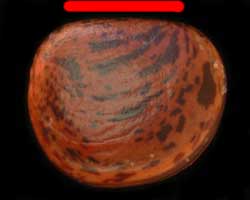
|
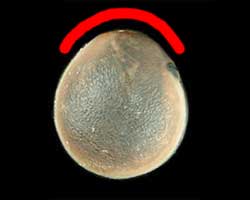 |
|
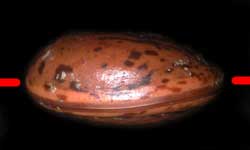
|
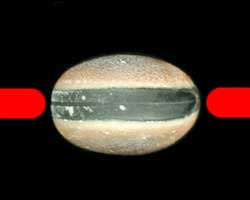 |
|
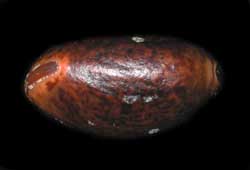 |
||
|
| ||
The Leaves
| Comparison and contrast of typical leaves... their shape, veination, and adornment. | ||
| Dioclea reflexa, Sea Purse | Notes | Mucuna sloanei, Brown Hamburger Bean |

|
Note the very hairy nature of the young leaves and stem for Dioclea. Although the Mucuna leaves do have hairs, the extent (in this case) is much less than is present in Dioclea. |
 |
 The Encyclopedia of Life (EOL) web page has a photo of leaves of Dioclea reflexa. |
Venation: The veins of the paird leaflets in Dioclea and Mucuna is quite distinct. The venation in the paired leaflets of Mucuna are unequal, with the portion of the leaflet on one side of the main vein much being larger than the other, creating a "lobed" appearance. Hairs: The mature leaves of Dioclea are more hairy than those of Mucuna. Examine the leaves at an angle, in the right light, and the hairs will be quite evident. |
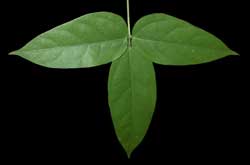 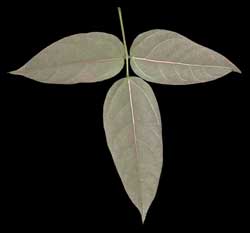
|
The Flowers
| Comparison and contrast of typical flowers. | ||
| Dioclea, Sea Purses | Notes | Mucuna, Hamburger Beans |
| Waiting for plants to sprout and grow to take a photo of the flowers. Meanwhile, this web page has a photo of a spike of flowers of Dioclea reflexa. See also this web page for Dioclea hexandra. |
Flowers of Dioclea occur on an upright "spike", while flowers of Mucuna hang downward on a peduncle and are arrayed in a "umbelliform cluster", or a "pseudoraceme cluster ". |
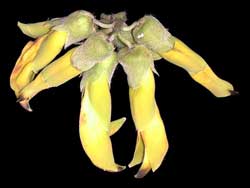 Umbelliform cluster of Mucuna sloanei flowers. 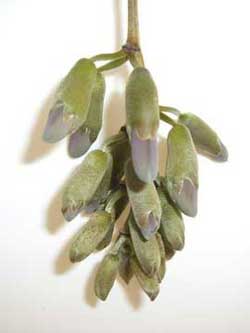 Pseudoracemose cluster of Mucuna urens flowers. Photo: Gina Reed |
The Pods
| "Pod" is the term which refers to the fruit of legumes. | ||
| Dioclea reflexa, Sea Purse | Notes | Mucuna sloanei, Brown Hamburger Bean |
| Waiting for plants to sprout and grow to take a photo of the pods. Meanwhile, this "Wayne's Word" web page has a photo of a pod of Dioclea wilsonii and Dioclea reflexa. (scroll way down the page) |
The seed pods of Mucuna species typically have stinging hairs (called trichomes), while the seed pods of Dioclea species typically do not. | 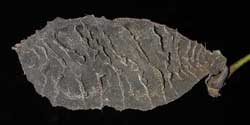 |
Taxonomy
Classifications group similar organisms and seem to always be in a state of flux or revision. Presently, both of these genera, Dioclea and Mucuna, are considered to be in the family: Fabaceae ...previously considered to be called the Leguminosae (s.l.) or Papilionaceae (s.s.). Plants in this third largest family of land plants are commonly known as a legumes, peas or beans. Faba, in Latin, means "bean". The "type species" (below) is that species selected to exemplify the characteristics of those plants within the Genus. |
|
| Dioclea Hook f. | Mucuna Adans. |
| The name after the genus: You may see this genus presented as "Dioclea Hook f." or "Dioclea HBK" or "Dioclea (Hook f.) C. Wright" or "Dioclea Kunth". This is the name of the person who first described the species; if that name is in parenthesis, the species was first named and placed within a genus other than the one presently shown. Etymology: Named for Diocles, considered by the ancient Greeks to be second only to Hippocrates in his knowledge of Plants. Lectotype species: Dioclea sericea HBK. A "lectotype" is one that is designated after the genus was originally described, because the "type" species was never established or was invalidly designated. |
The name after the genus: You may see this genus presented as "Mucuna Adans." Mucuna is a "conserved" name. The original spelling was Macuna but because Mucuna had become so embedded in popular usage, it was conserved and officially designated as the valid spelling of the genus. Etymology: From mucunan, the name given these plants by the Tupis, South American Indians of the Amazon valleys of Brazil. Type species: Mucuna urens (L.) DC. |
| Generic characteristics of Dioclea and Mucuna Information taken and modified from: Allen, O.N. and E.K. Allen. 1981. The Leguminosae. A Source Book of Characteristics, Uses, and Nodulation. University of Wisconsin Press; 812 pp. | |
|
30-50 species. Vines, woody or shrubby, tall, climbing. Leaves pinnate 3-foliate; stiples sebaceous; stipules sometimes present. Flowers large, many, violet, blue, or white, in clusters on sessile or stalked nodes on axillary, elongated racemes; bracts narrow; bracteoles orbicular, membraneous; calyx campanulate, silky haired-inside; lobes 4 or 5, upper 2 united, lowest lobe longest; standard ovate, reflexed, with 2 inflexed, basal auricles; wings free, oblong; keel blunt, straight, or incurved, short; stamens 10, pseudo-monadelphous, vexillary stamen free only at the base; anthers all fertile or alternate ones small, abortive; ovary subsessile; ovules 2-many; style incurved, usually not bearded, dilated above; stigma terminal, truncate. Pod linear-oblong, compressed or turgid, leathery, 2-valved, both sutures narrow-winged or upper one thickened, dehiscent or indehiscent. Seeds usually globose with linear hilum. |
100 to 150 species. Herbs, vines, rarely shrubs, climbing, woody, tall, rarely short and erect. Leaves pinnate 3-foliate, usually large; leaflets asymmetric, often oblique-ovate, usually hairy, aciculate; stiples usually present; stipules small, usually caducous. Flowers large, showy, purple, orange, scarlet, red, or yellowish fascicled-racemose on axillary peduncles or subcymose at the apex of the peduncle; bracts and bracteoles small, caducous,; calyx often hairy, bilabiate; lobes 5 ovate, upper lip bilobed, lower lip trilled, longer; standard sessile, ovate-elliptic, folded inward eared at the base, ears often upturned. subequal to the wings; wings oblong-ovate, incurved, sessile, eared, often adherent to the keel; keel sessile, linear-oblong, incurved or beaked, often longer than and joined to the wings; stamens 10, diadelphous; anthers unequal, alternately longer and basifixed, shorter and dorsifixed, bearded; ovary sessile, few-ovules, villous, surrounded by a poorly developed, usually basal, cupular to lobular disk; style linear, filiform; stigma small, capitate, terminal. Pod thick, ovate to oblong, often covered with brown, stinging hairs, 2-valved, septate within. Seeds 1-10, large, rounded, discoid with hilum more or less one half the circumference or smaller ovoid, with a short, raised hilum. |